June 1941. Redeployment of the first echelon of the control of the southern front. Nomination to the front

Immobilization of departments and management services of LF
It was possible to find information on the commanders of the LF department, who were not part of the PA. Were called up from the 22 reserve on June 1941: Senior Assistant to the Head of the Artillery Administration Division A.Z. Krasnov (Krasno-Presnensky RVK), senior assistant of the PA Artillery Headquarters P.E. Egorov (Sverdlovsk RVK of Moscow), assistant to the head of the supply department of the health department I.Ya. Osipov (Kominternovsky RVK), assistant chief of the highway maintenance department of the logistics department T.I. Titov (Sokolnichesky RVK), fuel supply dispatcher P.I. Simakov (Tagansky RVK), commander of the communications management I.I. Volegov (called Moskvoretsky RVK). Red Army man (driver) financial department headquarters of the front Finogenov Ya.P. 22.6.41 was called in (Kirovsky RVK) and departed on the same day on an M-1 vehicle at law firm. Perhaps along with him went to the front and a motorcycle platoon to protect the field control of the Law Faculty.
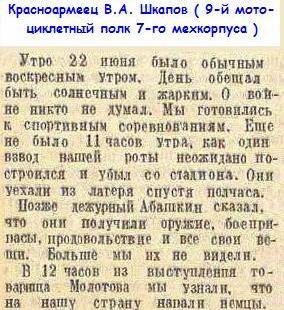
In accordance with the statistical materials, a separate battalion of guards of the LF administration is listed in the active army from 25.6.41 and began its formation in Vinnitsa.
In the book “K.A. Vershinin. The fourth air "says that after the start of the Great Patriotic War, the operational control group of the LF Air Force left Moscow for Vinnitsa. The group included: Commander P.S. Shelukhin (before 22.6.41, Deputy Commander of the Air Force of the Moscow Military District), Deputy Commander for Political Affairs V.I. Alekseeva (before 22.6.41, Head of the Special Frames Department of the Main Directorate of Political Propaganda of the Spacecraft), Head of the Public Association K.N. Odintsov (before 22.6.41 - head of the intelligence department of the headquarters of the MVO air force), head of the intelligence department G.А. Drozdov (before 22.6.41, the chief of staff of the IAP); Chief of Communications K.A. Korobkova (before 22.6.41, the communications director of the MVO Air Force), the flagship navigator V.I. Suvorov (until 22.6.41, the flag navigator of the MVO Air Force). Two days later, the rest of the Air Force headquarters departed for the front. The newly formed management was manned only on 60-65%. By 1 in July, the management work was largely streamlined.
From the information provided it is clear that the headquarters and field management of the LF began its deployment only after the start of the war. How so? After all, according to Note NPO USSR and the General Staff of the spacecraft in the Politburo of the Central Committee of the CPSU (b) and the Council of People's Commissars of the USSR (February 1941), a description of the plan for the mobilization deployment of the SC says that the mobilization plan is deploying 9 front field directorates? The Far Eastern Front already existed. Deployment of front-line directorates was to be carried out in ZabVO, ZakVO, LVO, PribOVO, ZOVOVO, KOVO, ArVO and MVO. If the telegram about the deployment of front-line control went off in ArVO 19 June, then why wasn’t the deployment of the same control begun in the Moscow Military District? The answer lies on the surface.
The scheme took into account the deployment of troops in case of war, which did not necessarily have to start on June 22. The document was supposed to include the possibility of starting a war in 1941 or in 1942.
The English Ambassador to the USSR wrote in a telegram from 23.4.41:
Of course, at that time, the leadership of the country and the SC were hoping for a postponement of the war, since, according to intelligence data, the number of German divisions at the border had hardly changed since November 1940.
According to the same A note it was planned to deploy 30 mechanized corps, 30 motorized and 60 tank divisions. The formation of such a number of formations and associations was not planned by the beginning of the war. These were plans for the future.
Remember that the head of GABTU responded to General DD. Lyolyushenko?
- When will tanks arrive to us? After all, we feel the Germans are preparing ...
“Do not worry,” said Lt. Gen. Ya.N. Fedorenko. - According to the plan, your body should be completed in full in 1942 year.
- And if the war?
- The spacecraft is strong enough without your body ...
In June, the situation changes somewhat. On 22 June, the 21 mechanized corps had 30 flamethrower tanks, 98 tanks T-26 and BT-7 in 15. Despite the small number of obsolete tanks, the corps is planned for use in the Daugavpils direction. XNUMX Jun corps commanders conduct reconnaissance. This does not contradict the fulfillment of the combat mission by the mechanized corps in the future after the receipt of additional materiel.
Similar events occur in the Moscow Military District. In early June, General Tyulenev announced to the senior commanders of the district headquarters: "... We are ordered to prepare for the functions of field front control ...". However, the deadlines were not named and no specific tasks were assigned to the command personnel. Also not named theater of operations, where you have to turn around front-line management.
SC communications parts
Without which frontline control cannot exist yet? No communication! Without proper communications, the front command is not headquarters, but only a large group of commanders.
Each military district (in wartime — the front) was serviced by its own separate regiment of communications (OPS), while the other OPS were in the Reserve of the Main Command (RGK). In peacetime, at the army headquarters there was a separate liaison battalion, which, upon completion of mobilization, was supposed to be increased to a full liaison regiment. With five army headquarters already formed OPS. All parts of the communications were staffed in peacetime states.
В article It is said that the pre-war communications troops of the RGK consisted of 19-ops (14 district and 5 army), 25 separate communication battalions, 16 separate radio battalions of special purpose (for conducting radio interception) and 17 communication centers (one for NKO and one for each military district). These units existed only on paper and had to be mobilized on 9 ... 10-th day of the war.
According to the plans of the General Staff, during the war, after the deployment of units, the structure of the communications troops was formed from 37-ips, 98-i separate battalions of wire communication and 298-i separate mouth companies. In reality, only 17 regiments (lack of 48,6%), 25 battalions (lack of 74,4%) and 4 companies (lack of 98%) were created.
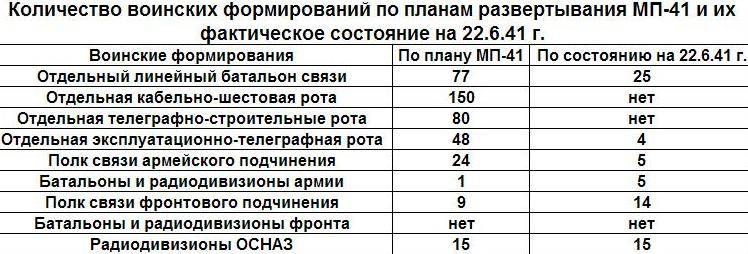
Prior to the mobilization of the RGK communications units, it was supposed to organize communications in the front-army command line in the initial period of the war at the expense of the network of the People’s Commissariat of Communications. Such an approach, adopted by the General Staff, was one of the reasons for the defeat of Zapovo and PribOVO troops in border battles due to the loss of command and control.
After the announcement of the mobilization period, the readiness of the communications inspectorates was set to 3 days; readiness of telegraph construction and telegraph production companies - from 6 to 11 days. If for 2 and subsequent operational-strategic echelons such terms of the formations of communications agencies could be acceptable, then they did not correspond to the tasks of the command of the covering armies that entered the battle in the first days of the war.
It should be noted that on 22 June 1941, the shortage in units and in educational institutions of communication was: for commanding personnel - 24% and for junior officers (sergeants) - about 10%.
When planning combat operations in the initial period of the war, the General Staff did not attach importance to possible communications problems in the border districts during this period. In recent peace days, no decisions have been taken on the deployment of communications units and the release of communications weapons from warehouses.
Readers who read the series of articles by the author of Victoria should remember that a similar situation was with parts of the airspace test. Their full deployment began to occur only after the outbreak of war. According to the standards, the deployment time was up to 7-8 hours. Somewhere the points of the warning system turned around, somewhere the personnel were scattered or destroyed during the nomination. As a result, on the first half of the day on June 22, air defense and air force units were serviced only by airborne command posts (an average of four points to the army front). This led to a delay in the receipt of information of the "air" series at fighter aerodromes aviation and in terms of air defense. Part of the enemy aircraft was not even detected before they entered the target zone. And after the deployment of the VNOS system, problems began with wired communication lines. For example, by the evening of June 22, almost complete loss of communication occurs in PribOVO.
Directive No. 1 emphasizes that the increase in the nominal composition should not be made. Immediately after the start of the war (in 4-00), a cipher telegram (PC) is sent from the command station of PribOVO with a request for permission to call the communications men.
1. Weakness of front-line and army communications units in terms of size and power relative to their tasks.
2. Non-equipped communication centers of the army and the front.
3. Insufficient development of wires from the Panevezys and Dvinsky communication centers.
4. Lack of communications to ensure rear communication.
5. Weak security of communications property of the district, army communications units and the air force.
Please: 1. Allow the partial mobilization of front-line and army communications units, by mobilizing communications regiments, line battalions, operational companies and communication squadrons ... P. Klenov
A misunderstanding of the problems of organizing communications existed not only in the General Staff, but also in the levels of control of the fronts and armies.
Head of Communications Department PribOVO General PM KurochkinDescribing the pre-war method of combat training of the staffs and command personnel of the communications troops of the army and district levels of command, he wrote:
As for the communication necessary for controlling the air defense, air force, rear, it was either not taken into account at all, or its organization was studied in special classes that did not deal with communication issues for operational management, i.e. again favorable conditions were created. Under such conditions the commanders and staffs got used to the fact that the organization of communication poses no difficulties, there will always be communication at their disposal, and not any, but wired.
Is it not the appearance of well-being in communication that is created in peacetime that the combined-arms commanders and staffs neglected the difficulties in organizing communications that occurred at every step from the very beginning of the war? Was this not one of the reasons that led to great difficulties in command of the troops, and often to complete loss of control ...
The headquarters of PribOVO knew about this problem and long before the war informed the General Staff about possible problems. PM Kurochkin:
Responsibility for organizing and ensuring communications of the General Staff with the fronts and fronts with the armies was assigned, respectively, to the head of the communications department of the spacecraft and to the heads of communications of the fronts. In addition to the apparatus of the head of the spacecraft communications department, there was also another body - the communications department of the operational management of the General Staff, who also was in charge of developing communications issues, but was not subordinate to the headquarters communications department of the spacecraft. In addition, the communications departments of the Air Force and Navy were relatively independent. Such a situation could not but affect the quality of communication management by the central office. The General Staff of its forces and communications equipment to ensure communications with the fronts and armies by the beginning of the war did not have and did not plan to deploy, relying on the Communications Commissariat. The head of the spacecraft communications department, the communications department of the operational management of the General Staff, the Main Directorate of Air Defense, reported to G.К. Zhukov ...
Front parts of communication law
In accordance with A statement of the military units of the SF units at 1.7.41, the front communications forces include the 40-th OPS, which included: 377-th separate linear communications battalion (OLBS), 378-OLBS, 379-OLBS, 3-th a separate cable pole cable company (okshr), 240-i okshr, 252-i okshr, 255-i separate telegraph and operational company (äther), military post station №1. The indicated parts of the July 1 connection still arrive at the front.
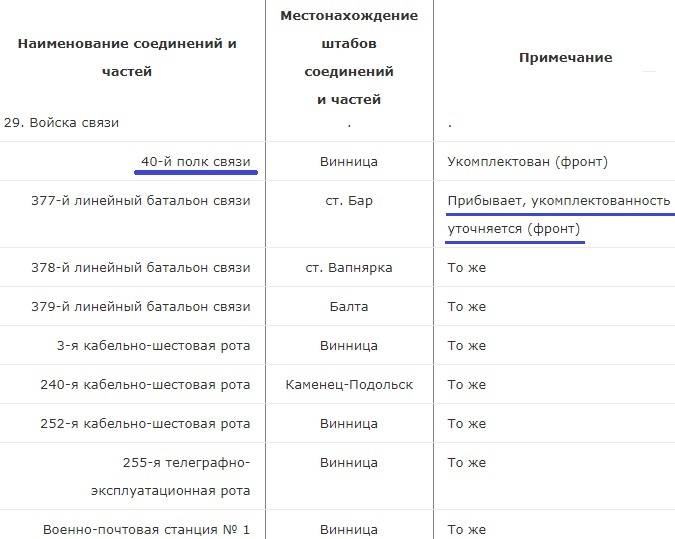
According to other sources, the telegraph battalion, which existed before the arrival of 40-ops, arrived at the front of the LF communications troops.
It was possible to find several servicemen who served in some of the indicated communications units. All of them are called to the SC only after the start of the war. In 377 th olbs, military personnel residing in Moscow were called up by 23.6.41: Averin I.L. (Tagansky RVK), Voskoboinik GD (Sokolniki RVK), Zhuravsky D.V. (Rostokinsky RVK) and Krylov V.A. (Proletarian RVK). Korotkov A.S. was called up to 378. 22.6.41 (Moskvoretsky RVK). 240 was called to XINUMX in Lisin E.A. (Komsomolsk RVK Ivanovo region). It can be assumed that this was also the case in the other parts of the 24.6.41 ops.
According to the statistical materials 377, 378 and 379 olbs, 252 hatch in the current army are listed with 1.7.41 g, and 240 hatch and 255 hither with 25.6.41. Information on 3 hight in the collection is missing. The appearance on the front of 25 June 240 OSR and 255 äter is questionable, since Vedomosti states that they arrive on July 1. In addition, serviceman Lisin E.A. was called in 240-th Okshr 24 June. Consequently, the 240-th hp has been deployed since June 22 and June 24 continued its formation. Therefore, she simply could not find herself on the front of 25 June.
As part of the troops of the Moscow Military District there was only one district OPS - 1-ops. In peacetime, the inner-county communications regiments were maintained according to staff No. 14 / 913 and had a population of 840 people. The tasks of forming the whole set of front-line and army communications units, as well as spare parts were assigned to the district and army regiments and battalions of peacetime. Each of these parts had to form from 8 to 14 separate parts of the connection. After the start of the war, 1 ops and 40 ops began to unfold on the basis of 67 ops. The memory of the company commander 67 th ops I.E. Milkina:
[23 June] I went to the Sverdlovsk District Military Commissariat for appointment to the army in the field. There I introduced myself to the commission as the commander of the radio rotation. Immediately, I was assigned as commander of the 67 radio battalion ops. Two days I was given to receive the material part and the formation of a radio battalion. Recruitment took place on the territory of the military communications unit in the area of Matrosskaya Silence. On the third day of [26.6.41], we went to the North-Western Front ...
In the created parts of the communication there were a lot of personnel called up from the reserve. The correlation of personnel and recruited personnel was found only for the initial period of the Soviet-Finnish war: in the Moscow military district, on 500, personnel when deploying communication units sent to the theater of military operations accounted for about 6500 people called up from the reserve. By the beginning of World War II, the command already had negative experience in the mobilization deployment of front-line and army sets of communications units (meaning the Soviet-Finnish war, as well as operations to bring Soviet troops into the Baltic States, in the western regions of Belarus and Ukraine) 1941, in fact, failed to change anything (Almanac. Tom 4. Military connection).
The personnel called up from the reserve had not been practically called up for training before. In 1940, the head of communications ZOVOVA, General AG Grigoriev (shot together with the commander of Zapovo) wrote in a letter to the head of the communications department of the spacecraft:
The beginning of the war was unexpected for the military registration and enlistment offices of the city of Moscow and the Moscow region. The period of vacations and the departure of people for rest on Sunday led to an increase in the time needed to recruit teams, even if they had a reserve. An example is the appointment of I.E. Milkin, who was not part of the assignment of 67 ops, the commander of the radio battalion.
M.N. Sbitnev (military commissar of the Dzerzhinsky district of Moscow):
V. Kotelnikov:
Since the deployment of the LF front-line communications regiment was not launched on June 20, the rise of field control in the 20.6.41 Moscow Military District could not be associated with the advancement of control to Vinnitsa in anticipation of war.
Advancement of LF field management
According to the memoirs of General Zakharov, before the outbreak of war, the OdVO headquarters did not suspect the inclusion of district troops in the LF. From Moscow, no information on this issue in the event of war was received by the district. After the beginning of the war, telegrams from the Kharkov and Odessa military districts begin to arrive from the General Staff with notification of the establishment of the Law Faculty.
PC №1456 / op from 22.6.41 G .:
18 Army Combat Log:
PC №05 23-25 23.6.41 G .:
1. Order of the People’s Commissar of Defense No. 04 was created by LF. The Commander of the Law Force was appointed General of the Army Tyulenev, a member of the Military Council — Army Commissar 1 of the rank Zaporozhets, and Chief of Staff of the Front Major General Shishenin. Front headquarters in the morning 24.6 - Vinnitsa.
2. 18 Army with 00-05 25.6.41 r. Is included in the law firm ... Vatutin
PC №08 23-30 23.6.41 G .:
1. Order of the People’s Commissar of Defense No. 04 was created by LF. Commander-in-Chief of the Law Faculty appointed General of the Army Tyulenev, member of the Military Council — Army Commissar of 1 rank Zaporozhets, Chief of Staff of the Front Major General Shishenin
2. 9 Army with 00-05 25.6 1941 g is included in the Law Firm.
3. The 9 Special Corps with the 00-05 25.6 is removed from the 9 Army and reports directly to the commander of the LF forces.
4. About establishing communication with front headquarters to inform me. Vatutin
Departure of an unplanned special train 22 June was so hasty and unexpected that nobody knew the situation in the area of their future location at the headquarters of the Law Faculty. A.F. Hrenov:
I went to the departments and offices of the headquarters to obtain information, topographic maps and other documents relating to the EAs, as well as the road and airfield network in the LF strip. The situation in the headquarters somewhat puzzled me. The offices were deserted - their owners, which was quite natural, ended up in Ternopil. But those who remained were not vested with sufficient authority and did not have access to documents of interest to me ...
I was rescued by workers of the Engineering Department who were on the spot. From memory, they described the state of URs, roads and airfields to me. They sketched an approximate layout of the reinforced concrete gearbox in Vinnitsa, on the shores of the Southern Bug, and that was where our front-line control should have been located. They also warned that the CP may not have the necessary means of communication and the full calculation of the serving team ...
We arrived in Vinnytsia at dawn on 24 June ... The scheme obtained in Kiev made it easy to find a command post ... In the evening of the next day, the second echelon of the field control of the front arrived safely ...
As General I.V. recalled. Tyulenev, about the existence of the command post in Vinnitsa, he was not informed either in the General Staff or in the headquarters of the Kiev Military District. Ivan Vladimirovich learned about it from the head of the engineering troops of the front, although the point was built back in 1939-1940. I.V. Tyulenev:
M.V.Zakharov:
V.D. Tarasova:
Start of operation of the LF department
On June 25, the command of the LF sent its first Directive to the troops.
The second. I was appointed Commander of the Law Faculty, Army Commissar of the First Rank Zaporozhets, I was appointed a member of the Military Council, Major-General Shishenin ...
LF Commander Army General Tyulenenev
Member of the Military Council Army Commissar I Rank Zaporozhets
Chief of Staff of the front, Major General Shishenin.
The uncomplicated situation at the SF, as compared with the situation on the Western and Northwestern fronts, allowed the field control team to arrive and manage the troops and get up to date only in early July. The lack of communications weapons at the command post in Vinnitsa in the early days of front-line management workers had to use the means of the People's Commissariat of Communications, which did not guarantee the secrecy of the ongoing negotiations and limited the number of communication lines. The Western and North-Western fronts did not have such a delay ...
At 22.6.41, statewide, the number of people at the front line headquarters was 333.
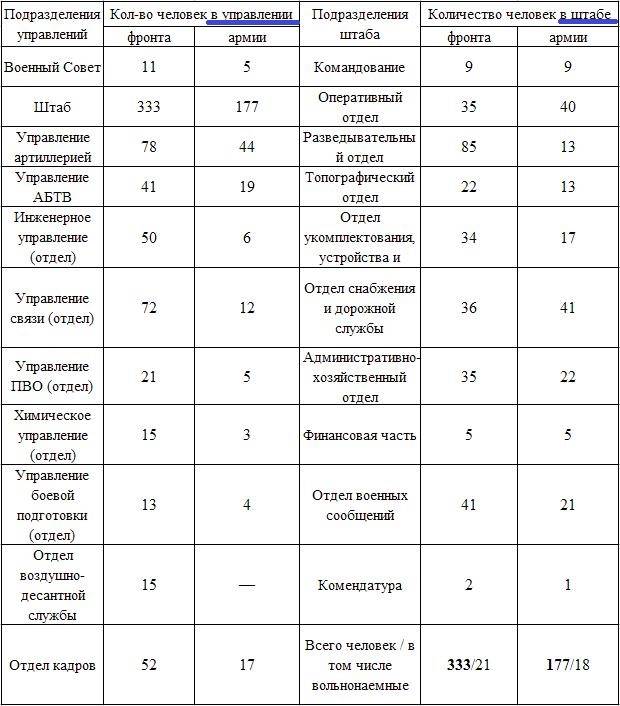
There is a note to the table that the management of the fronts (armies) included political administrations (departments), directorates (departments) of the Air Force command, and special departments that were contained in their states. The servicemen of the said directorates or departments were not included in the total number of servicemen shown in the figure.
As of June 27, there is a large shortage of staff at the LF headquarters: there are about 100 people. At the headquarters of the law firm there is a guard company in which there are about 160 fighters.
Human protection:
a) Open and equip by 28.6.41 ten open field slits with full capacity normal profiles ... to cover 160 people in them. fighters.
b) To open and equip the 29.6.41 with six open-field field slots of the full profile, normal capacity for 100 people ... shelter in them of the personnel of the 1080 military unit ...
After the redeployment of the front management of the LF, the shortage of personnel was eliminated in early July. According to the state, the number of people in management was 925, and as of July 12, 1190 people were already in charge of management and ordinary members of 1668 (3246 people in total).
Major-General GD was the Chief of Staff of the Law Faculty from 22 to 30 in June. Shishenin. It is difficult to say how he supervised the work of the headquarters with little or no communication, having a large shortage of personnel, most of whom were called up from the reserve. As you remember, the personnel called up from the reserve in the PA were not prepared at all. The commander of the front forces, Tyulenev, and a member of the Military Council, Zaporozhets, "signaled" to Moscow that the front headquarters, headed by Sishenin "Completely helpless in both organizational and operational work". They probably tried to absolve themselves of responsibility for the bad work of controlling the front forces ... On June 30, General Shishenin was replaced by the new chief of staff, Colonel F.K. Korzhevich.
In the 12.8.41 Directive, Mr. Stalin indicated Budyonny:
The deployment of LF management was too messy and unplanned, which can only be connected with the unexpected start of the war in June 1941 for the command of the spacecraft and not understanding how the German command would carry out military operations during the initial period of the war. With the introduction of troops into Bessarabia in 1940, everything was more organized (article).
We reviewed the events and documents related to the deployment of the field management of the SF. The author considers it superfluous to repeat the conclusions that follow from the presented material. According to the author, the refusal of the Chief of the General Staff of the proposal of the Military Council of the OdVO to deploy front-line command at the beginning of the war on the basis of the district headquarters and the redeployment of one army from internal districts was a mistake.
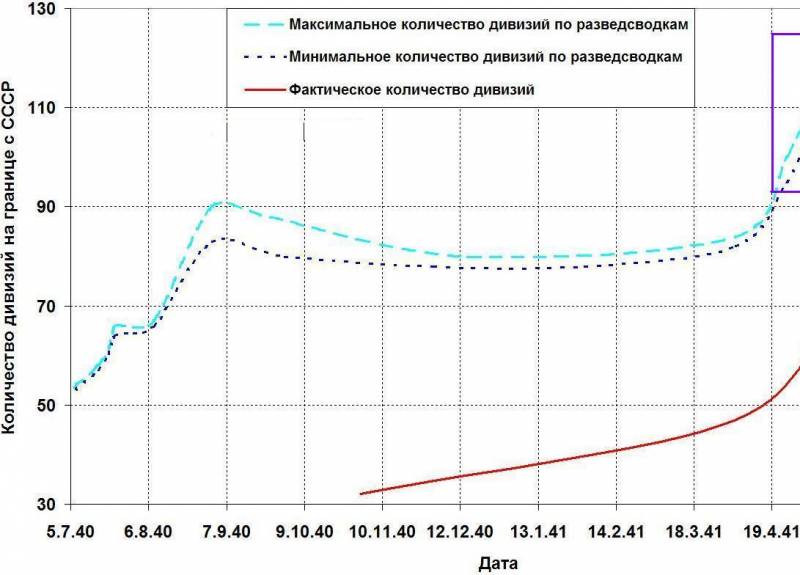
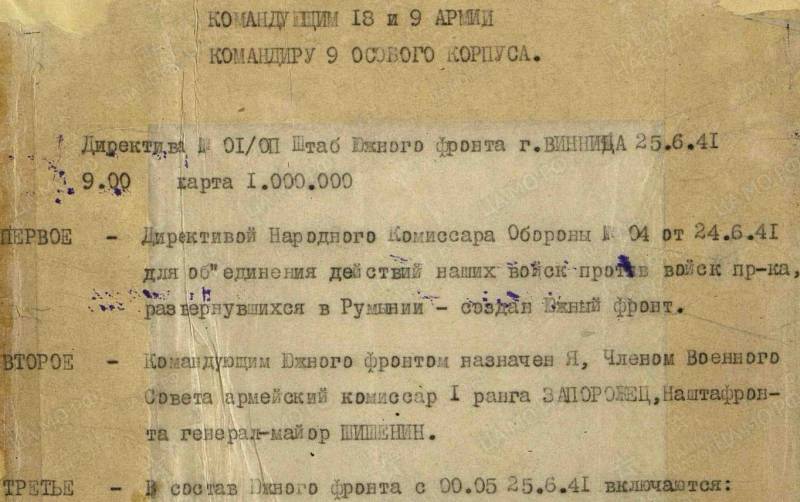
Information